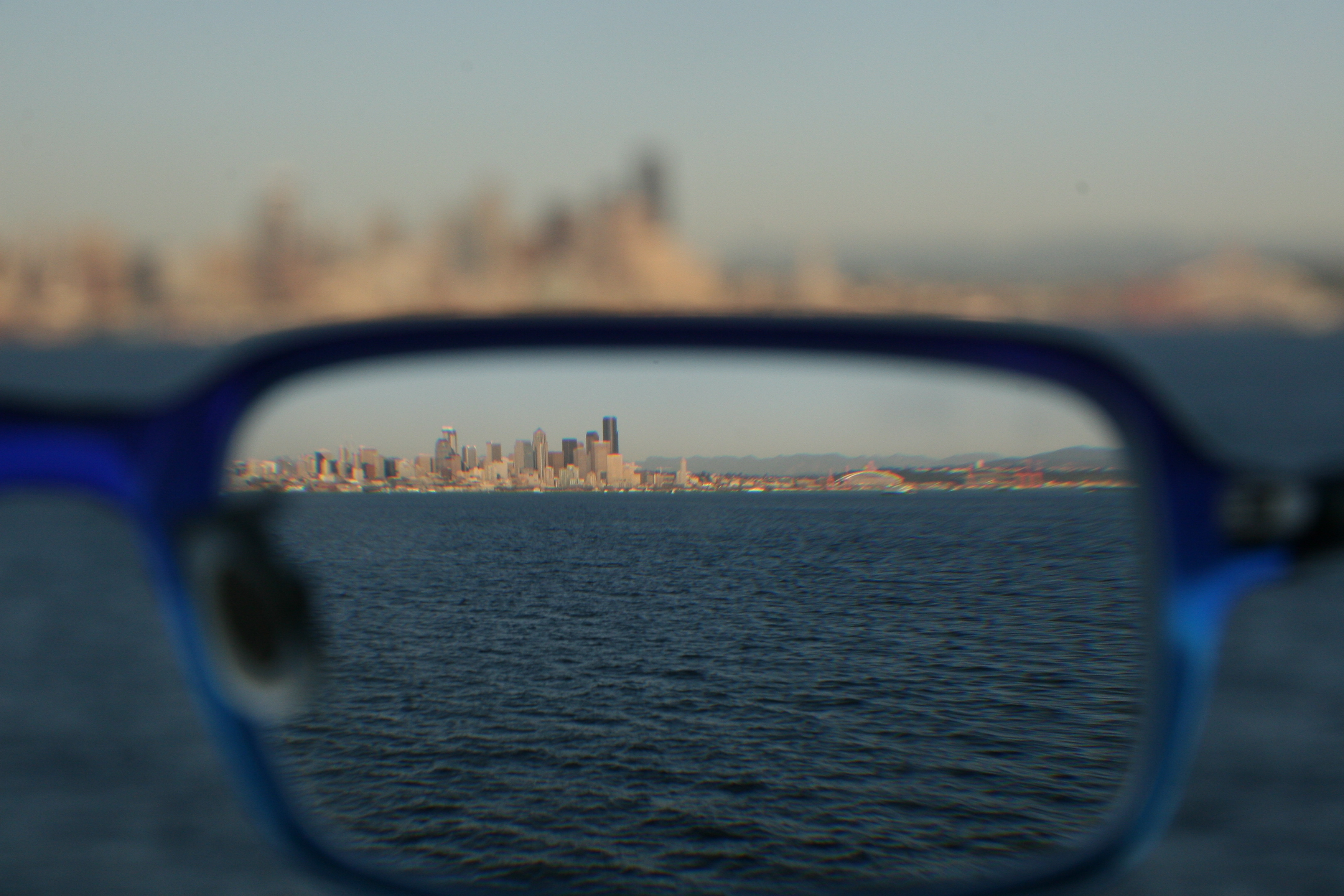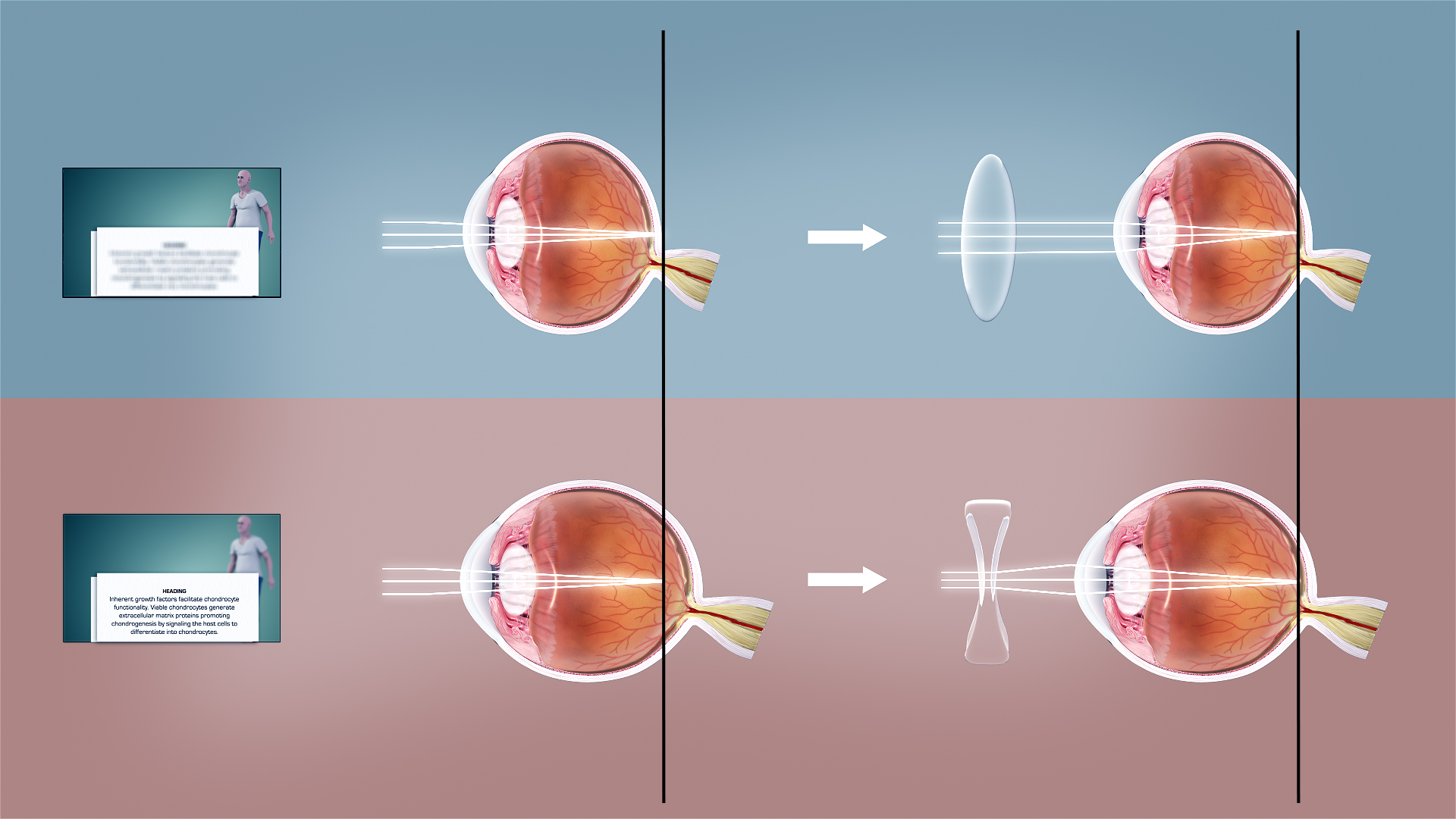|
Glasses
Glasses, also known as eyeglasses or spectacles, are vision eyewear, with lenses (clear or tinted) mounted in a frame that holds them in front of a person's eyes, typically utilizing a bridge over the nose and hinged arms (known as temples or temple pieces) that rest over the ears. Glasses are typically used for vision correction, such as with reading glasses and glasses used for nearsightedness; however, without the specialized lenses, they are sometimes used for cosmetic purposes. Safety glasses provide eye protection against flying debris for construction workers or lab technicians; these glasses may have protection for the sides of the eyes as well as in the lenses. Some types of safety glasses are used to protect against visible and near-visible light or radiation. Glasses are worn for eye protection in some sports, such as squash. Glasses wearers may use a strap to prevent the glasses from falling off. Wearers of glasses that are used only part of the time may have the ... [...More Info...] [...Related Items...] OR: [Wikipedia] [Google] [Baidu] |
Sunglasses
Sunglasses or sun glasses (informally called shades or sunnies; more names below) are a form of protective eyewear designed primarily to prevent bright sunlight and high-energy visible light from damaging or discomforting the eyes. They can sometimes also function as a visual aid, as variously termed spectacles or glasses exist, featuring lenses that are colored, polarized or darkened. In the early 20th century, they were also known as sun cheaters (cheaters then being an American slang term for glasses). Since the 1930s, sunglasses have been a popular fashion accessory, especially on the beach. The American Optometric Association recommends wearing sunglasses that block ultraviolet radiation (UV) whenever a person is in the sunlight to protect the eyes from UV and blue light, which can cause several serious eye problems. Their usage is mandatory immediately after some surgical procedures, such as LASIK, and recommended for a certain time period in dusty areas, when leaving ... [...More Info...] [...Related Items...] OR: [Wikipedia] [Google] [Baidu] |
Corrective Lens
A corrective lens is a lens (i.e. a transmissive optical device) that is typically worn in front of the eye to improve daily vision. The most common use is to treat refractive errors: myopia, hypermetropia, astigmatism, and presbyopia. Glasses or "spectacles" are worn on the face a short distance in front of the eye. Contact lenses are worn directly on the surface of the eye. Intraocular lenses are surgically implanted most commonly after cataract removal but can be used for purely refractive purposes. Prescription of corrective lenses Corrective lenses are typically prescribed by an ophthalmologist or an optometrist. The prescription consists of all the specifications necessary to make the lens. Prescriptions typically include the power specifications of each lens (for each eye). Strengths are generally prescribed in quarter-diopter steps (0.25 D) because most people cannot generally distinguish between smaller increments (e.g., eighth-diopter steps / 0.125 D). The use ... [...More Info...] [...Related Items...] OR: [Wikipedia] [Google] [Baidu] |
Eyewear
Eyewear consists of items and accessories worn on or over the eyes, for fashion or adornment, protection against the environment, and to improve or enhance visual acuity. Common forms of eyewear include glasses (also called ''eyeglasses'' or ''spectacles''), sunglasses, and contact lenses. Eyewear can also include more utilitarian forms of eye protection, such as goggles. Conversely, blindfold A blindfold (from Middle English ') is a garment, usually of cloth, tied to one's head to cover the eyes to disable the wearer's sight. While a properly fitted blindfold prevents sight even if the eyes are open, a poorly tied or trick blindf ...s are a form of eyewear used to ''block'' vision for a variety of purposes. {{Glasses Sunglasses ... [...More Info...] [...Related Items...] OR: [Wikipedia] [Google] [Baidu] |
Stereoscopy
Stereoscopy (also called stereoscopics, or stereo imaging) is a technique for creating or enhancing the illusion of depth in an image by means of stereopsis for binocular vision. The word ''stereoscopy'' derives . Any stereoscopic image is called a stereogram. Originally, stereogram referred to a pair of stereo images which could be viewed using a stereoscope. Most stereoscopic methods present a pair of two-dimensional images to the viewer. The left image is presented to the left eye and the right image is presented to the right eye. When viewed, the human brain perceives the images as a single 3D view, giving the viewer the perception of 3D depth. However, the 3D effect lacks proper focal depth, which gives rise to the Vergence-Accommodation Conflict. Stereoscopy is distinguished from other types of 3D displays that display an image in three full dimensions, allowing the observer to increase information about the 3-dimensional objects being displayed by head and eye mov ... [...More Info...] [...Related Items...] OR: [Wikipedia] [Google] [Baidu] |
3D Glasses
Stereoscopy (also called stereoscopics, or stereo imaging) is a technique for creating or enhancing the illusion of depth in an image by means of stereopsis for binocular vision. The word ''stereoscopy'' derives . Any stereoscopic image is called a stereogram. Originally, stereogram referred to a pair of stereo images which could be viewed using a stereoscope. Most stereoscopic methods present a pair of two-dimensional images to the viewer. The left image is presented to the left eye and the right image is presented to the right eye. When viewed, the human brain perceives the images as a single 3D view, giving the viewer the perception of 3D depth. However, the 3D effect lacks proper focal depth, which gives rise to the Vergence-Accommodation Conflict. Stereoscopy is distinguished from other types of 3D displays that display an image in three full dimensions, allowing the observer to increase information about the 3-dimensional objects being displayed by head and eye mov ... [...More Info...] [...Related Items...] OR: [Wikipedia] [Google] [Baidu] |
Eye Protection
Eye protection is protective gear for the eyes, and sometimes face, designed to reduce the risk of injury. Examples of risks requiring eye protection can include: impact from particles or debris, light or radiation, wind blast, heat, sea spray or impact from some type of ball or puck used in sports. Eye protection are typically separated into categories based on the style of eye wear and the hazard they are designed to reduce. There categories include: Spectacles with side protection; Goggles; Welding helmet; Welding Hand Shields; Non-Rigid Helmets (hoods); Face shield; and Respirator Face pieces. Styles Spectacles Safety glasses or spectacles, although often used as a catch-all term for all types of eye protection, specifically revers to protective equipment that closely resembles common eye wear. To meet most national standards, spectacles must include side shields to reduce the ability of debris to get behind the lenses from the side. Safety glasses can often mount i ... [...More Info...] [...Related Items...] OR: [Wikipedia] [Google] [Baidu] |
Refractive Error
Refractive error, also known as refraction error, is a problem with focus (optics), focusing light accurately on the retina due to the shape of the human eye, eye and or cornea. The most common types of refractive error are myopia, near-sightedness, hyperopia, far-sightedness, astigmatism, and presbyopia. Near-sightedness results in far away objects being blurred vision, blurry, far-sightedness and presbyopia result in close objects being blurry, and astigmatism causes objects to appear stretched out or blurry. Other symptoms may include double vision, headaches, and eye strain. Near-sightedness is due to the length of the eyeball being too long, far-sightedness the eyeball too short, astigmatism the cornea being the wrong shape, and presbyopia aging of the lens of the eye such that it cannot change shape sufficiently. Some refractive errors occur more often among those whose parents are affected. Diagnosis is by eye examination. Refractive errors are corrected with eyeglasses, ... [...More Info...] [...Related Items...] OR: [Wikipedia] [Google] [Baidu] |
Myopia
Near-sightedness, also known as myopia and short-sightedness, is an eye disease where light focuses in front of, instead of on, the retina. As a result, distant objects appear blurry while close objects appear normal. Other symptoms may include headaches and eye strain. Severe near-sightedness is associated with an increased risk of retinal detachment, cataracts, and glaucoma. The underlying mechanism involves the length of the eyeball growing too long or less commonly the lens being too strong. It is a type of refractive error. Diagnosis is by eye examination. Tentative evidence indicates that the risk of near-sightedness can be decreased by having young children spend more time outside. This decrease in risk may be related to natural light exposure. Near-sightedness can be corrected with eyeglasses, contact lenses, or a refractive surgery. Eyeglasses are the easiest and safest method of correction. Contact lenses can provide a wider field of vision, but are associated with ... [...More Info...] [...Related Items...] OR: [Wikipedia] [Google] [Baidu] |
Nearsightedness
Near-sightedness, also known as myopia and short-sightedness, is an eye disease where light focuses in front of, instead of on, the retina. As a result, distant objects appear blurry while close objects appear normal. Other symptoms may include headaches and eye strain. Severe near-sightedness is associated with an increased risk of retinal detachment, cataracts, and glaucoma. The underlying mechanism involves the length of the eyeball growing too long or less commonly the lens being too strong. It is a type of refractive error. Diagnosis is by eye examination. Tentative evidence indicates that the risk of near-sightedness can be decreased by having young children spend more time outside. This decrease in risk may be related to natural light exposure. Near-sightedness can be corrected with eyeglasses, contact lenses, or a refractive surgery. Eyeglasses are the easiest and safest method of correction. Contact lenses can provide a wider field of vision, but are associated with ... [...More Info...] [...Related Items...] OR: [Wikipedia] [Google] [Baidu] |
Presbyopia
Presbyopia is physiological insufficiency of accommodation associated with the aging of the eye that results in progressively worsening ability to focus clearly on close objects. Also known as age-related farsightedness (or age-related long sight in the UK), it affects many adults over the age of 40. A common sign of presbyopia is difficulty reading small print which results in having to hold reading material farther away. Other symptoms associated can be headaches and eyestrain. Different people will have different degrees of problems. Other types of refractive errors may exist at the same time as presbyopia. This condition is similar to hypermetropia or far-sightedness which starts in childhood and exhibits similar symptoms of blur in the vision for close objects. Presbyopia is a typical part of the aging process. It occurs due to age related changes in the lens (decreased elasticity and increased hardness) and ciliary muscle (decreased strength and ability to move the len ... [...More Info...] [...Related Items...] OR: [Wikipedia] [Google] [Baidu] |
Eyeglass Prescription
An eyeglass prescription is an order written by an eyewear prescriber, such as an optometrist, that specifies the value of all parameters the prescriber has deemed necessary to construct and/or dispense corrective lenses appropriate for a patient. If an eye examination indicates that corrective lenses are appropriate, the prescriber generally provides the patient with an eyewear prescription at the conclusion of the exam. The parameters specified on spectacle prescriptions vary, but typically include the patient's name, power of the lenses, any prism to be included, the pupillary distance, expiration date, and the prescriber's signature. The prescription is typically determined during a refraction, using a phoropter and asking the patient which of two lenses is better, or by automated refractor, or through the technique of retinoscopy. A dispensing optician will take a prescription written by an optometrist and order and/or assemble the frames and lenses to then be dispensed to ... [...More Info...] [...Related Items...] OR: [Wikipedia] [Google] [Baidu] |
Optometry
Optometry is a specialized health care profession that involves examining the eyes and related structures for defects or abnormalities. Optometrists are health care professionals who typically provide comprehensive primary eye care. In the United States and Canada, optometrists are those that hold a Doctor of Optometry degree. They are trained and licensed to practice medicine for eye related conditions, in addition to providing refractive (optical) eye care. In the United Kingdom, optometrists may also practice medicine (and provide refractive care) for eye related conditions. The Doctor of Optometry title can also be used in the UK for those that hold the postgraduate O.D. degree. Within their scope of practice, optometrists are considered physicians and bill medical insurance(s) (example: Medicare) accordingly. Moreover, many participate in academic research for eye related conditions and disease. Optometrists are the only health care professionals with a first professional ... [...More Info...] [...Related Items...] OR: [Wikipedia] [Google] [Baidu] |









